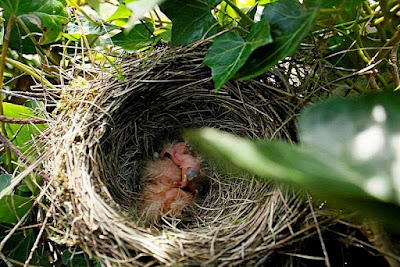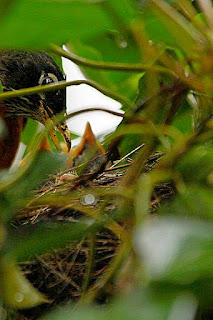American Robin
Of all the birds in North America, the iconic American Robin (Turdus migratorius) is perhaps the most familiar. They are so familiar, in fact, that we rarely get excited when spotting one. This is a shame because they are terrific birds. Robins are large, attractive songbirds, easy to identify. At the crack of dawn, they will be the first birds heard singing in long repeating phrases. These are appropriately referred to as "dawn calls." They will repeat the concert again at dusk.
My neighbor Dan Codd took all the photos here and kindly shared them for this post. They chronicle a pair who raised three young in his yard in a nest about seven feet/2 meters off the ground. In the breeding season, the males will grow black head feathers to attract females. Once the pairs have formed, they will remain monogamous through the season. Three to seven eggs are laid in a color we have come to call "robin's egg blue."
Typically, American Robins will raise two broods every season. My neighbors should not be surprised if the pair comes back to raise a second family. Enjoy this springtime family album courtesy of my neighbor Dan. Hopefully, these photos will reveal how admirable and enjoyable even ordinary birds can be.
The habitat preferred by Robins is open forest, forest edges, meadows and back yard gardens which may account for their familiarity. My local birds stalk me when I am gardening. They have learned that I kick up worms and bugs when I am digging and planting. The minute I step away, they come right in to gobble up the goodies.
Locally, American Robins are year around residents, but the birds that breed here will head south for the winter. The birds that breed in Alaska and Canada will spend the winter here. A group of Robins is called a "worm." Don't ask me why. On gentle winter days, worms of several dozen birds will gather in my yard to forage. It's always an amazing sight.
This has been a very wet and chilly spring for us. Naturally, under these conditions, the attentive parent will serve as both blanket and umbrella:
The three baby Robins grew quickly and the conditions in the nest became quite crowded. Still in the nest, this young trio is already showing panache and attitude. They have all fledged successfully and Dan notes having seen the parents in the canopy. We'll report back if they return to the nest for a second brood.
Photos: Dan Codd














